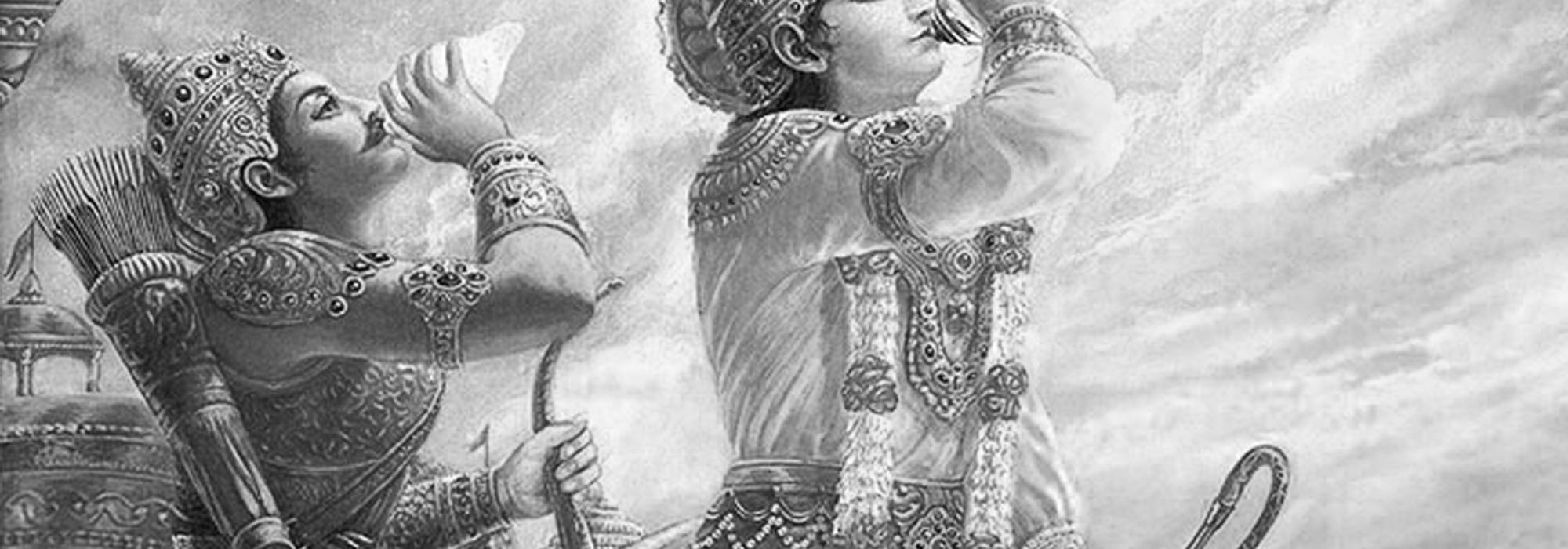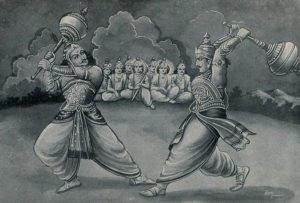With this part, we conclude the translation series of the preface to Vacanabhārata. The current article describes the literary approach of AR Krishna Sastri in composing the prose rendition of the Mahābhārata in Kannada. Drawing inspiration from his approach, the current translators, Arjun Bharadwaj and Hari Ravikumar are working on bringing out a prose rendition of the Mahābhārata in English.
The article also contains some autobiographical details that throw light on the meticulousness of the author.
While composing this work, my primary focus has been on poetry and literary value. The story must be interesting and as far as possible should be rich with emotional details, evoking rasa. Descriptions, literary embellishments, dharma, and ethics (nīti) must have an optimum proportion. I wanted to capture in this work everything that is emotionally rich, profound, and has poetic value; but it should also not grow beyond limits. The language should be crisp and easily accessible – this was my aim. Although the original Sanskrit work is immense, the portions that contain descriptions are relatively small. The descriptions go well with the situation and the nature of the characters; it is not merely description for the sake of description. It is not overly embellished like in the poetry of later days. Wherever embellishments have been added, they are striking. I have not let go of any such instances; we find too much of elaboration in the descriptions of war and in the segments where dharma and ethics are preached. Nevertheless it is true that the epic itself is a story of war and has dharma and ethics as its goal. Thus it is natural to have the structure it has. I have captured the synopsis of those portions; especially those that come into the purview of direct experience and that which will help us lead a good life – here and hereafter. I have omitted entire segments and I have summarized other segments.
The treatment of the war is reduced only to a few pages in the current work [i.e. Vacanabhārata]. One can see the essence of the descriptions of war in the Virāṭa-parva. A similar kind of description occurs in the parvas relating to war [Bhīṣma-parva, Droṇa-parva, Karṇa-parva, etc.] but in greater detail. Thus I have picked up only the major incidents from those parvas. There is a lot of repetition in parts that deal with dharma and ethics; those portions are elaborate and can be boring. The repetition in the original could be due to different reasons, but that is not relevant here. It is sufficient, however, for our present purpose that the repeated portions appear just once. Another major quality of the original work is that it is devoid of excessive śṛṅgāra and śṛṅgārābhasa unlike later poetry. The southern recensions of the epic contain a few verses that might seem vulgar in the descriptions of Satyavatī and Ūrvaśī. There is enough evidence to pronounce that they are later interpolations. Prof. V S Sukthankar does not have those in the critical edition. The entire episode of Ūrvaśī’s curse is of this kind. If one examines closely the dialogues of Uttara, Duśśāsana and Kīcaka, whenever they seem to be vulgar or inappropriate, we can conclusively state—with the backing of evidence—that they are interpolations. The kind of ridicule that we see in Kumāravyāsa Bhārata and Jaiminī Bhārata are present in the Mahābhārata only to a small extent. Whatever is present is limited in word and meaning in the original; wherever it seems excessive, it is easy to show that it is interpolation. I shall give an example here. In the Karṇa-parva, Bhīma who is fighting with Duśśāsana says, “Duśśāsana! Fortunately you have come in the line of my vision. Come! I’ll repay all your debts with suitable interest.” The southern recension, however, has an extra line: “Recall what I declared in the sabhā when you dared to touch Kṛṣṇā!” Unafraid, Duśśāsana says in a mocking tone, “Even if I try recalling, I don’t think I can. I’ll tell you what I remember. Listen. All of you suffered in the house of lac, which I had created and you spent your days and nights fearing us; finally, you gave up all attempts at finding comfort and people looked at your with disdain; you lived the life of hunters surviving on wild meat, roaming about in the forest, and reached Pāñcāla-nagara. There, by some play of deceit you managed to have Pāñcālī married to Arjuna. After that, you shameless idiots followed the words of your mother and like ignoble men all of you fell on Draupadī. I remember all this. I also remember how in the sabhā Śakuni managed to turn you all into slaves along with your wife!” After writing these sentences although I felt that they go well with Duśśāsana’s wicked character, for a moment I thought that such statements don’t go well with the profundity of the Mahābhārata. I thus looked through several other recensions. I could not find this portion in the northern recensions. My mind became much calmer. I scratched out those lines and proceeded.
This however does not mean that the author of the epic is a recluse, a person detached from the world, a blind follower of dharma, a person who loves roaming about in the artificial world of kavi-samayas (poetic conventions), a mere preacher of dharma and darśanas. We can learn his true nature if we cast a glance at situations such as the consolation provided by Kunti to the poor brāhmaṇa family tormented by the wickedness of Bakāsura. That is a small but complete picture of a household – a beautiful story that begins with tears and ends with a smile. The conversations that take place between the husband, the wife, and the daughter are intense; on the other hand, the few innocent words uttered by the little boy are profound in another sense. As much as raja-nīti (royal ethics) is important, so is saṃsāra-nīti (family ethics). It is in this sense that upākhyānas of Nala, Sāvitrī, etc. seem out of the world and have captured the hearts of the people.
The culture of the ancient world is captured in the Mahābhārata like no other work. The Mahābhārata is invaluable to anyone who wants to understand human history and the essence of human civilization.
Sanskrit scholars who have read the epic in the original might feel that I should have included a few portions in my Vacanabhārata. This is natural, and it varies with the tastes of individuals. At times, I too have felt that certain portions could have been included. However, keeping in mind the size of the work, I have had to cut them down. After getting the feedback from my readers, I will try to include them in the future editions wherever necessary. People who are interested further can go to the original or read one of the several translations available.
Among the topics discussed so far, it might seem that I have deviated from the traditional outlook at some places; I am not against the tradition; I have always believed that one must adhere to dharma and ethics but retain independence in their execution. My purpose is to place before the reader such possibilities. In the light of the incidents that have happened in the past, we can correct our present-day life and can sculpt it in a beautiful way – such should be the result of studying history. Therefore I have mentioned whatever I felt was right and whatever was the product of my study. I have never claimed that that is the only truth or that is the only possible philosophy. If anyone comes forward to help me correct my views and opinions or if someone helps me to further strengthen them, I will always be grateful for any such help; if the work is fortunate to see another edition, I shall incorporate those details.
As I was writing the current work, my daughter Shanta and my grand-daughter Leela both read it with a lot of interest and affection. They even performed an auspicious ritual to commemorate the completion of every beautiful section and parva in my work; they celebrated the completion of every section with singing and chanting. Once the work was complete, they read through the whole book all over again and expressed their delight. They even felt proud that they were able to read the work in the manuscript form itself, before the rest of the world. Even as they were reading it, I asked them now and then, “Is any portion boring? Did you find it hard to understand something?” The answer was “No” most of the times. I repeated almost the same question every day, only to get back the same answer. I am under the impression that their reply was not because of their affection towards me. One among them was a high-school student and the other was studying in college. My aim has always been to reach my work even to young students like them by keeping it simple, yet retaining the intensity, with all its purity. Only then, will it culture the mind of the readers and give an aesthetic experience. If the Kannada readers declare that my purpose is served, my task is fulfilled and I shall be grateful for the same.
References used by Dr. AR Krishna Sastri in writing the preface to Vacanabhārata
[1] Monier Williams. Indian Wisdom, London (1893)
[2] A A MacDonnell. A History of Sanskrit Literature (1900)
[3] E W Hopkins. Religions of India (1896)
[4] E W Hopkins. The Great Epic of India: Its Character and Origin (1901)
[5] E W Hopkins. Epic Mythology (1915)
[6] E W Hopkins. ‘The Princes and People of India,’ Chapter XI in Cambridge History of India, Vol. I, pp. 251–75 (1922)
[7] E W Hopkins. Ethics of India (1924)
[8] C V Vaidya. The Mahabharata: A Criticism (1905)
[9] C V Vaidya. Epic India as described in the Mahabharata and Ramayana (1933)
[10] M Winternitz. A History of Indian Literature, Vol. I, pp. 311–475 (1927)
[11] M Winternitz. ‘The Serpent Sacrifice Mentioned in the Mahabharata’ (J. B. R. A. S., August 1926)
[12] M Krishnamachariar. History of Classical Sanskrit Literature, pp. 1–78 (1937)
[13] V Venkatachellam Iyer. Notes of a Study of the Preliminary Chapters of The Mahabharata, Being an Attempt to Separate Genuine from Spurious Matter (1922) [The author of this work has examined the first few parvas in the Bombay, Madras, and Calcutta editions as well as in Nannaya Bhatta’s Telugu translation and given his conclusions about which parts of the text were present earlier and which were added later.]
[14] A D Paluskar. ‘Twenty-five Years of Epic and Puranic Studies’ in Progress of Indic Studies, 1917–42 [We can learn from this work the list of all the books and articles published in recent years (c. 1950) about the Mahābhārata as well as their summaries.]
[15] S Radhakrishnan. Indian Philosophy, Vol. I, Chapter VIII (1923)
[16] S Radhakrishnan. Religion and Society (1947)
[17] S Sorensen. Index to the Names in the Mahabharata (1904)
[18] E P Rice. The Mahabharata: Analysis and Index (1934)
[19] ಬೆನಗಲ್ ರಾಮರಾವ್ ಮತ್ತು ಪಾನ್ಯಂ ಸುಂದರಶಾಸ್ತ್ರಿ. ಪುರಾಣನಾಮಚೂಡಾಮಣಿ (೧೯೪೧)
[20] ಬಂಕಿಮಚಂದ್ರ. ಶ್ರೀಕೃಷ್ಣಚರಿತ್ರೆ (ಆರ್ ವ್ಯಾಸರಾಯರ ಕನ್ನಡ ಭಾಷಾಂತರ) (೧೯೩೭)
[21] ಮಾಸ್ತಿ ವೆಂಕಟೇಶ ಅಯ್ಯಂಗಾರ್. ಭಾರತತೀರ್ಥ (೧೯೫೨)


















































